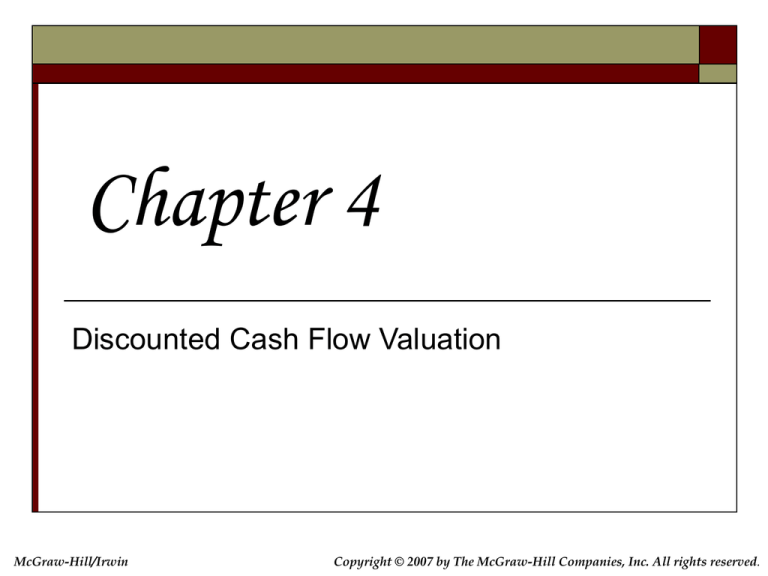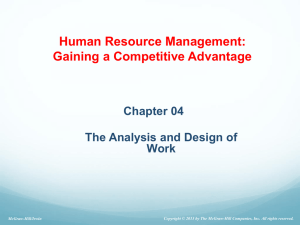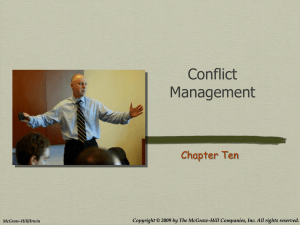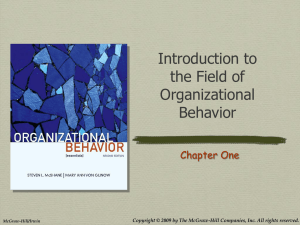
Chapter 4
Discounted Cash Flow Valuation
McGraw-Hill/Irwin
Copyright © 2007 by The McGraw-Hill Companies, Inc. All rights reserved.
Key Concepts and Skills
Be able to compute the future value and/or
present value of a single cash flow or series of
cash flows
Be able to compute the return on an
investment
Be able to use a financial calculator and/or
spreadsheet to solve time value problems
Understand perpetuities and annuities
McGraw-Hill/Irwin
Copyright © 2007 by The McGraw-Hill Companies, Inc. All rights reserved.
Chapter Outline
4.1 Valuation: The One-Period Case
4.2 The Multiperiod Case
4.3 Compounding Periods
4.4 Simplifications
4.5 What Is a Firm Worth?
McGraw-Hill/Irwin
Copyright © 2007 by The McGraw-Hill Companies, Inc. All rights reserved.
4.1 The One-Period Case
If you were to invest $10,000 at 5-percent interest
for one year, your investment would grow to
$10,500.
$500 would be interest ($10,000 × .05)
$10,000 is the principal repayment ($10,000 × 1)
$10,500 is the total due. It can be calculated as:
$10,500 = $10,000×(1.05)
The total amount due at the end of the investment is
call the Future Value (FV).
McGraw-Hill/Irwin
Copyright © 2007 by The McGraw-Hill Companies, Inc. All rights reserved.
Future Value
In the one-period case, the formula for FV can
be written as:
FV = C0×(1 + r)T
Where C0 is cash flow today (time zero), and
r is the appropriate interest rate.
McGraw-Hill/Irwin
Copyright © 2007 by The McGraw-Hill Companies, Inc. All rights reserved.
Present Value
If you were to be promised $10,000 due in one year
when interest rates are 5-percent, your investment
would be worth $9,523.81 in today’s dollars.
$9,523.81
$10,000
1.05
The amount that a borrower would need to set aside
today to be able to meet the promised payment of
$10,000 in one year is called the Present Value (PV).
Note that $10,000 = $9,523.81×(1.05).
McGraw-Hill/Irwin
Copyright © 2007 by The McGraw-Hill Companies, Inc. All rights reserved.
Present Value
In the one-period case, the formula for PV can
be written as:
PV
C1
1 r
Where C1 is cash flow at date 1, and
r is the appropriate interest rate.
McGraw-Hill/Irwin
Copyright © 2007 by The McGraw-Hill Companies, Inc. All rights reserved.
Net Present Value
The Net Present Value (NPV) of an
investment is the present value of the
expected cash flows, less the cost of the
investment.
Suppose an investment that promises to pay
$10,000 in one year is offered for sale for
$9,500. Your interest rate is 5%. Should you
buy?
McGraw-Hill/Irwin
Copyright © 2007 by The McGraw-Hill Companies, Inc. All rights reserved.
Net Present Value
NPV $9,500
$10,000
1.05
NPV $9,500 $9,523.81
NPV $23.81
The present value of the cash inflow is greater
than the cost. In other words, the Net Present
Value is positive, so the investment should be
purchased.
McGraw-Hill/Irwin
Copyright © 2007 by The McGraw-Hill Companies, Inc. All rights reserved.
Net Present Value
In the one-period case, the formula for NPV can be
written as:
NPV = –Cost + PV
If we had not undertaken the positive NPV project
considered on the last slide, and instead invested our
$9,500 elsewhere at 5 percent, our FV would be less
than the $10,000 the investment promised, and we
would be worse off in FV terms :
$9,500×(1.05) = $9,975 < $10,000
McGraw-Hill/Irwin
Copyright © 2007 by The McGraw-Hill Companies, Inc. All rights reserved.
4.2 The Multiperiod Case
The general formula for the future value of an
investment over many periods can be written
as:
FV = C0×(1 + r)T
Where
C0 is cash flow at date 0,
r is the appropriate interest rate, and
T is the number of periods over which the cash is
invested.
McGraw-Hill/Irwin
Copyright © 2007 by The McGraw-Hill Companies, Inc. All rights reserved.
Future Value
Suppose a stock currently pays a dividend of
$1.10, which is expected to grow at 40% per
year for the next five years.
What will the dividend be in five years?
FV = C0×(1 + r)T
$5.92 = $1.10×(1.40)5
McGraw-Hill/Irwin
Copyright © 2007 by The McGraw-Hill Companies, Inc. All rights reserved.
Future Value and Compounding
Notice that the dividend in year five, $5.92,
is considerably higher than the sum of the
original dividend plus five increases of 40percent on the original $1.10 dividend:
$5.92 > $1.10 + 5×[$1.10×.40] = $3.30
This is due to compounding.
McGraw-Hill/Irwin
Copyright © 2007 by The McGraw-Hill Companies, Inc. All rights reserved.
Future Value and Compounding
$1.10 (1.40)
$1.10 (1.40)
$1.10 (1.40)
$1.10 (1.40)
5
4
3
2
$1.10 (1.40)
$1.10
$1.54
$2.16
$3.02
$4.23
$5.92
0
1
2
3
4
5
McGraw-Hill/Irwin
Copyright © 2007 by The McGraw-Hill Companies, Inc. All rights reserved.
Present Value and Discounting
How much would an investor have to set
aside today in order to have $20,000 five
years from now if the current rate is 15%?
PV
$20,000
0
1
$9,943.53
2
4
5
$20,000
(1.15)
McGraw-Hill/Irwin
3
5
Copyright © 2007 by The McGraw-Hill Companies, Inc. All rights reserved.
How Long is the Wait?
If we deposit $5,000 today in an account paying 10%,
how long does it take to grow to $10,000?
FV C0 (1 r )
$10,000 $5,000 (1.10)
T
(1.10)
T
$10,000
T
2
$5,000
ln( 1.10) ln( 2)
T
T
ln( 2)
ln( 1.10)
McGraw-Hill/Irwin
0.6931
7.27 years
0.0953
Copyright © 2007 by The McGraw-Hill Companies, Inc. All rights reserved.
What Rate Is Enough?
Assume the total cost of a college education will be
$50,000 when your child enters college in 12 years.
You have $5,000 to invest today. What rate of interest
must you earn on your investment to cover the cost of
your child’s education?
About 21.15%.
FV C0 (1 r )
(1 r )
12
T
$50,000
$5,000
r 10
1 12
McGraw-Hill/Irwin
$50,000 $5,000 (1 r )
12
10
(1 r ) 10
1 12
1 1.2115 1 .2115
Copyright © 2007 by The McGraw-Hill Companies, Inc. All rights reserved.
Calculator Keys
Texas Instruments BA-II Plus
FV = future value
PV = present value
I/Y = periodic interest rate
P/Y
must equal 1 for the I/Y to be the periodic rate
Interest is entered as a percent, not a decimal
N = number of periods
Remember to clear the registers (CLR TVM) after
each problem
Other calculators are similar in format
McGraw-Hill/Irwin
Copyright © 2007 by The McGraw-Hill Companies, Inc. All rights reserved.
Multiple Cash Flows
Consider an investment that pays $200 one
year from now, with cash flows increasing by
$200 per year through year 4. If the interest
rate is 12%, what is the present value of this
stream of cash flows?
If the issuer offers this investment for $1,500,
should you purchase it?
McGraw-Hill/Irwin
Copyright © 2007 by The McGraw-Hill Companies, Inc. All rights reserved.
Multiple Cash Flows
0
1
200
2
3
4
400
600
800
178.57
318.88
427.07
508.41
1,432.93
McGraw-Hill/Irwin
Present Value < Cost → Do Not Purchase
Copyright © 2007 by The McGraw-Hill Companies, Inc. All rights reserved.
Valuing “Lumpy” Cash Flows
First, set your calculator to 1 payment per year.
Then, use the cash flow menu:
CF0
0
CF3
600
I
CF1
200
F3
1
NPV
F1
1
CF4
800
CF2
400
F4
1
F2
1
McGraw-Hill/Irwin
12
1,432.93
Copyright © 2007 by The McGraw-Hill Companies, Inc. All rights reserved.
4.3 Compounding Periods
Compounding an investment m times a year for
T years provides for future value of wealth:
r
FV C0 1
m
McGraw-Hill/Irwin
mT
Copyright © 2007 by The McGraw-Hill Companies, Inc. All rights reserved.
Compounding Periods
For example, if you invest $50 for 3 years at
12% compounded semi-annually, your
investment will grow to
.12
FV $50 1
2
McGraw-Hill/Irwin
23
$50 (1.06) $70.93
6
Copyright © 2007 by The McGraw-Hill Companies, Inc. All rights reserved.
Effective Annual Rates of Interest
A reasonable question to ask in the above
example is “what is the effective annual rate of
interest on that investment?”
FV $50 (1
.12
)
23
$50 (1.06) $70.93
6
2
The Effective Annual Rate (EAR) of interest is
the annual rate that would give us the same
end-of-investment wealth after 3 years:
$50 (1 EAR) $70.93
3
McGraw-Hill/Irwin
Copyright © 2007 by The McGraw-Hill Companies, Inc. All rights reserved.
Effective Annual Rates of Interest
FV $50 (1 EAR) $70.93
3
(1 EAR)
3
$70.93
$50
13
$70.93
EAR
$50
1 .1236
So, investing at 12.36% compounded annually
is the same as investing at 12% compounded
semi-annually.
McGraw-Hill/Irwin
Copyright © 2007 by The McGraw-Hill Companies, Inc. All rights reserved.
Effective Annual Rates of Interest
Find the Effective Annual Rate (EAR) of an
18% APR loan that is compounded monthly.
What we have is a loan with a monthly
interest rate rate of 1½%.
This is equivalent to a loan with an annual
interest rate of 19.56%.
r
1
m
McGraw-Hill/Irwin
nm
12
.18
1
12
(1.015)
12
1.1956
Copyright © 2007 by The McGraw-Hill Companies, Inc. All rights reserved.
EAR on a Financial Calculator
Texas Instruments BAII Plus
keys:
description:
[2nd] [ICONV]
Opens interest rate conversion menu
Sets 12 payments per year
[↑] [C/Y=] 12 [ENTER]
Sets 18 APR.
[↓][NOM=] 18 [ENTER]
[↓] [EFF=] [CPT]
McGraw-Hill/Irwin
19.56
Copyright © 2007 by The McGraw-Hill Companies, Inc. All rights reserved.
Continuous Compounding
The general formula for the future value of an
investment compounded continuously over many
periods can be written as:
FV = C0×erT
Where
C0 is cash flow at date 0,
r is the stated annual interest rate,
T is the number of years, and
e is a transcendental number approximately equal
to 2.718. ex is a key on your calculator.
McGraw-Hill/Irwin
Copyright © 2007 by The McGraw-Hill Companies, Inc. All rights reserved.
4.4 Simplifications
Perpetuity
Growing perpetuity
A stream of cash flows that grows at a constant rate
forever
Annuity
A constant stream of cash flows that lasts forever
A stream of constant cash flows that lasts for a fixed
number of periods
Growing annuity
McGraw-Hill/Irwin
A stream of cash flows that grows at a constant rate for
a fixed number of periods
Copyright © 2007 by The McGraw-Hill Companies, Inc. All rights reserved.
Perpetuity
A constant stream of cash flows that lasts forever
0
PV
PV
C
C
C
1
2
3
C
C
C
(1 r )
(1 r )
2
(1 r )
…
3
C
r
McGraw-Hill/Irwin
Copyright © 2007 by The McGraw-Hill Companies, Inc. All rights reserved.
Perpetuity: Example
What is the value of a British consol that
promises to pay £15 every year for ever?
The interest rate is 10-percent.
0
£15
£15
£15
1
2
3
PV
£15
…
£150
.10
McGraw-Hill/Irwin
Copyright © 2007 by The McGraw-Hill Companies, Inc. All rights reserved.
Growing Perpetuity
A growing stream of cash flows that lasts forever
0
PV
PV
McGraw-Hill/Irwin
C
C×(1+g)
C ×(1+g)2
1
2
3
C
(1 r )
C (1 g )
(1 r )
2
C (1 g )
(1 r )
3
…
2
C
rg
Copyright © 2007 by The McGraw-Hill Companies, Inc. All rights reserved.
Growing Perpetuity: Example
The expected dividend next year is $1.30, and
dividends are expected to grow at 5% forever.
If the discount rate is 10%, what is the value of this
promised dividend stream?
$1.30
$1.30×(1.05)
$1.30 ×(1.05)2
…
0
1
PV
McGraw-Hill/Irwin
2
$1.30
.10 .05
3
$26.00
Copyright © 2007 by The McGraw-Hill Companies, Inc. All rights reserved.
Annuity
A constant stream of cash flows with a fixed maturity
C
C
C
C
0
PV
1
2
3
C
C
C
(1 r )
(1 r )
2
(1 r )
T
3
C
(1 r )
T
C
1
PV 1
T
r
(1 r )
McGraw-Hill/Irwin
Copyright © 2007 by The McGraw-Hill Companies, Inc. All rights reserved.
Annuity: Example
If you can afford a $400 monthly car payment, how
much car can you afford if interest rates are 7% on 36month loans?
$400
$400
$400
$400
0
1
2
3
36
$400
1
PV
$12,954.59
1
36
.07 / 12 (1 .07 12)
McGraw-Hill/Irwin
Copyright © 2007 by The McGraw-Hill Companies, Inc. All rights reserved.
What is the present value of a four-year annuity of $100
per year that makes its first payment two years from today if the
discount rate is 9%?
4
PV1
t 1
$297.22
$100
(1.09)
$323.97
0
t
$100
1
(1.09)
$100
1
2
$327 .97
$297 .22
PV
McGraw-Hill/Irwin
0
1.09
$100
(1.09)
2
$100
3
$100
(1.09)
3
$100
(1.09)
$100
4
4
$323.97
$100
5
Copyright © 2007 by The McGraw-Hill Companies, Inc. All rights reserved.
Growing Annuity
A growing stream of cash flows with a fixed maturity
C
C×(1+g) C ×(1+g)2
C×(1+g)T-1
0
PV
1
C
(1 r )
2
3
C (1 g )
(1 r )
2
T
1 g
C
PV
1
r g (1 r )
McGraw-Hill/Irwin
T
C (1 g )
(1 r )
T 1
T
Copyright © 2007 by The McGraw-Hill Companies, Inc. All rights reserved.
Growing Annuity: Example
A defined-benefit retirement plan offers to pay $20,000 per year
for 40 years and increase the annual payment by three-percent
each year. What is the present value at retirement if the discount
rate is 10 percent?
$20,000
$20,000×(1.03) $20,000×(1.03)39
0
1
2
40
40
$20,000
1.03
PV
$265,121.57
1
.10 .03 1.10
McGraw-Hill/Irwin
Copyright © 2007 by The McGraw-Hill Companies, Inc. All rights reserved.
Growing Annuity: Example
You are evaluating an income generating property. Net rent is
received at the end of each year. The first year's rent is
expected to be $8,500, and rent is expected to increase 7%
each year. What is the present value of the estimated income
stream over the first 5 years if the discount rate is 12%?
$8,500 (1.07)
$8,500 (1.07)
3
$8,500 (1.07)
$8,500 (1.07)
2
$8,500
0
1
$34,706.26
McGraw-Hill/Irwin
$9,095 $9,731.65
2
3
4
$10,412.87 $11,141.77
4
5
Copyright © 2007 by The McGraw-Hill Companies, Inc. All rights reserved.
4.5 What Is a Firm Worth?
Conceptually, a firm should be worth the
present value of the firm’s cash flows.
The tricky part is determining the size, timing
and risk of those cash flows.
McGraw-Hill/Irwin
Copyright © 2007 by The McGraw-Hill Companies, Inc. All rights reserved.
Quick Quiz
How is the future value of a single cash flow
computed?
How is the present value of a series of cash flows
computed.
What is the Net Present Value of an investment?
What is an EAR, and how is it computed?
What is a perpetuity? An annuity?
McGraw-Hill/Irwin
Copyright © 2007 by The McGraw-Hill Companies, Inc. All rights reserved.









